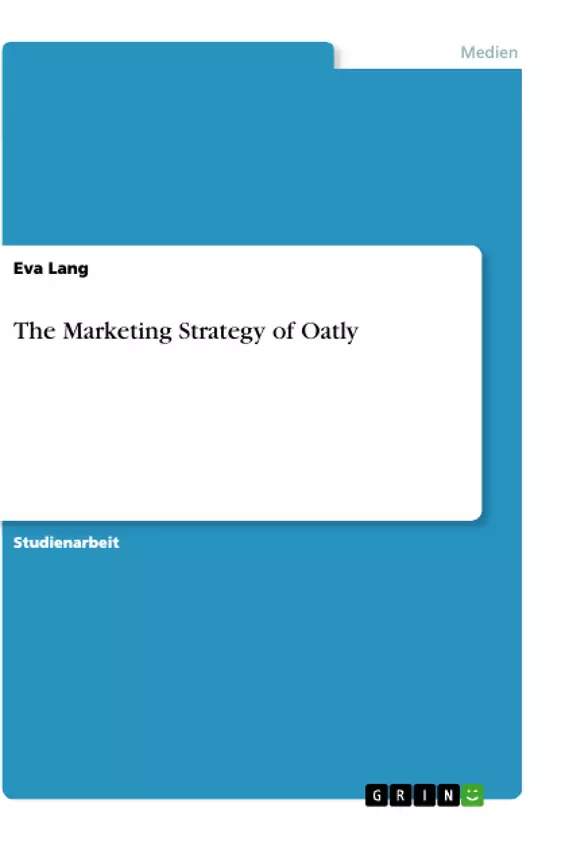This paper examines the marketing strategy of Oatly. Founded in the 1990s by a Swedish research team, Oatly is today one of the world’s most popular brands of oat-based dairy alternatives. With the relaunch in 2014, the brand has taken up the cause of consumers’ and the planet’s well-being, heralding the transformation from a food production company to a purposedriven lifestyle brand. From the original oat drink, the company has diversified into several categories and in more than 30 countries.
Oatly’s moral philosophy that revolves around the core values of sustainability, responsibility, and transparency resonates well with its main targets, i.e. consumers that seek dairy-free alternatives for health or ethical reasons. At the same time, refusing to be a niche brand, Oatly emphasizes its products’ taste and usability to make them appeal to the broad masses that are necessary to bring about the desired macrosocial shift. In fact, the brand’s purpose is not only to optimize its own resource efficiency but to drive a fundamental change in the global food system and society that goes beyond the own business. To this end, Oatly positions itself as an activist that aims to mobilize a debate around the cause of the planet’s health. These objectives are founded on the shared commitment of employees and suppliers which complete the four main strategic goals set by Oatly.
Inhaltsverzeichnis
- 1. Einleitung
- 2. Markenkapital: Definitionen und Perspektiven
- 3. Oatlys Markenidentität und -positionierung
- 4. Schlussfolgerungen
Zielsetzung und Themenschwerpunkte
Diese Arbeit untersucht das Markenkapital von Oatly im Kontext seiner purpose-driven Strategie. Die Analyse fokussiert auf die Herausforderungen, denen sich Oatly aufgrund seines Wachstums und rechtlicher Rahmenbedingungen gegenübersieht, und wie diese Herausforderungen das Markenkapital beeinflussen. Der Fokus liegt dabei auf der kundenbasierten Perspektive des Markenkapitals.
- Oatly's purpose-driven Strategie und deren Einfluss auf das Markenkapital
- Herausforderungen für Oatly (z.B. Blackstone-Deal, AM 171)
- Definitionen und Messungen von Markenkapital
- Die Rolle von Markenwissen und emotionalen Markenbeziehungen
- Der Einfluss interner Faktoren (Mitarbeiter, Lieferanten) auf das Markenkapital
Zusammenfassung der Kapitel
1. Einleitung: Die Einleitung stellt Oatly als purpose-driven Lifestyle-Marke vor und skizziert die zentralen Herausforderungen, denen sich das Unternehmen gegenübersieht. Dies umfasst den kontroversen Deal mit der Blackstone Group und die Auswirkungen der europäischen Änderung 171 (AM 171) auf die Markenpositionierung als milchfreie Alternative. Die Arbeit kündigt an, diese Herausforderungen aus der Perspektive des Markenkapitals zu analysieren.
2. Markenkapital: Definitionen und Perspektiven: Dieses Kapitel befasst sich mit verschiedenen Definitionen und Messansätzen von Markenkapital. Es wird zwischen einer finanziellen und einer kundenbasierten Perspektive unterschieden. Die Arbeit konzentriert sich auf die kundenbasierte Perspektive, wobei die Konzepte von Aaker und Keller (Markenwissen, Markenloyalität, Markenassoziationen) im Detail erläutert werden. Es wird betont, dass Markenkapital nicht nur in kognitiven Assoziationen, sondern auch in emotionalen Beziehungen zu den Konsumenten wurzelt. Der Einfluss interner Faktoren wie Mitarbeiterbindung und Lieferantenbeziehungen wird ebenfalls diskutiert.
3. Oatlys Markenidentität und -positionierung: Dieses Kapitel beleuchtet Oatlys Markenidentität als purpose-driven, business-to-human Marke, die sich als gesellschaftlicher Akteur und Beziehungspartner positioniert. Die interpretative Perspektive wird hervorgehoben, die den Bedeutungsprozess des Markenkapitals in der Interaktion mit der Kultur betont. Es wird der Zusammenhang zwischen Kundenequity und finanzieller Equity diskutiert, und wie sich dies auf die Messung und Bewertung von Oatlys Markenkapital auswirkt. Die Bedeutung von selbst-Ideal Kongruenz und der Aufbau einer starken Marken-Community wird hervorgehoben.
Schlüsselwörter
Markenkapital, Oatly, Purpose-driven Branding, Markenidentität, Markenpositionierung, Kundenperspektive, Markenwissen, emotionale Markenbeziehungen, AM 171, Blackstone Group, Nachhaltigkeit, Markenleistung, Brand Equity.
Häufig gestellte Fragen (FAQ) zur Analyse des Markenkapitals von Oatly
Was ist der Gegenstand dieser Arbeit?
Diese Arbeit analysiert das Markenkapital von Oatly, insbesondere im Kontext seiner purpose-driven Strategie. Der Fokus liegt auf der kundenbasierten Perspektive und den Herausforderungen, denen sich Oatly aufgrund von Wachstum und rechtlichen Rahmenbedingungen (z.B. Blackstone-Deal, AM 171) gegenübersieht.
Welche Themen werden behandelt?
Die Arbeit behandelt verschiedene Definitionen und Messansätze von Markenkapital (finanzielle vs. kundenbasierte Perspektive), Oatlys Markenidentität und -positionierung als purpose-driven Marke, den Einfluss der purpose-driven Strategie auf das Markenkapital, die Bedeutung von Markenwissen und emotionalen Markenbeziehungen, sowie die Herausforderungen durch den Blackstone-Deal und AM 171. Der Einfluss interner Faktoren wie Mitarbeiter und Lieferanten wird ebenfalls berücksichtigt.
Welche Kapitel beinhaltet die Arbeit?
Die Arbeit gliedert sich in vier Kapitel: 1. Einleitung (Vorstellung von Oatly und den zentralen Herausforderungen), 2. Markenkapital: Definitionen und Perspektiven (verschiedene Definitionen und Messansätze, Fokus auf die kundenbasierte Perspektive), 3. Oatlys Markenidentität und -positionierung (Analyse von Oatlys Markenidentität als purpose-driven Marke, Bedeutung von Kundenequity und finanzieller Equity), 4. Schlussfolgerungen (Zusammenfassung der Ergebnisse).
Wie wird das Markenkapital von Oatly gemessen?
Die Arbeit konzentriert sich auf die kundenbasierte Perspektive des Markenkapitals. Dabei werden Konzepte von Aaker und Keller (Markenwissen, Markenloyalität, Markenassoziationen) herangezogen. Es wird betont, dass Markenkapital nicht nur in kognitiven Assoziationen, sondern auch in emotionalen Beziehungen zu den Konsumenten wurzelt.
Welche Rolle spielt die purpose-driven Strategie von Oatly?
Die purpose-driven Strategie von Oatly spielt eine zentrale Rolle in der Analyse. Die Arbeit untersucht, wie diese Strategie das Markenkapital beeinflusst und welche Herausforderungen sich daraus ergeben.
Welche Herausforderungen werden für Oatly diskutiert?
Die Arbeit diskutiert die Herausforderungen, die sich aus dem kontroversen Deal mit der Blackstone Group und den Auswirkungen der europäischen Änderung 171 (AM 171) auf die Markenpositionierung ergeben. Diese Herausforderungen werden im Kontext des Markenkapitals analysiert.
Welche Schlüsselwörter charakterisieren die Arbeit?
Schlüsselwörter sind: Markenkapital, Oatly, Purpose-driven Branding, Markenidentität, Markenpositionierung, Kundenperspektive, Markenwissen, emotionale Markenbeziehungen, AM 171, Blackstone Group, Nachhaltigkeit, Markenleistung, Brand Equity.
- Quote paper
- Eva Lang (Author), 2021, The Marketing Strategy of Oatly, Munich, GRIN Verlag, https://www.grin.com/document/1190289



